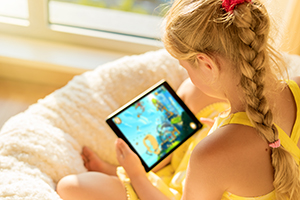Determine a screen time plan for summer
Pediatrics
Stellis Health – Monticello Clinic
It should come as no surprise that today’s children continue to spend more and more time in front of screens. TVs, iPads, smartphones, computers and video games all influence children. Parents, caregivers and educators need to take an active role in considering how media may influence development, behavior and learning.
Too much screen time can:
- Negatively affect play
- Lead to boredom
- Harm relationships
- Promote stereotyped behavior
- Interfere with children’s healthy development
- Affect the quality of sleep
- Lead to nagging
- Contribute to obesity

Parents Need Screen Time Limits Too
So what is a parent to do? A passive approach won’t work to protect your children and help them develop healthy media habits. As summer vacation begins, spend time thinking through your family’s values and how they relate to media use.
- Develop a family media plan. Determine screen time rules and limits for each child, considering their age, temperament, and the family’s needs as a whole. Limit media use to a supervised, shared family area and not children’s bedrooms. If you have older children and are changing or adjusting the rules, don’t be surprised if you receive push back. Be prepared to explain your reasoning.
- Be aware of your own screen time use. If your children see that you are not on screens, they are less likely to be on them too.
- Unplug babies. The American Academy of Pediatrics recommends no screen time under the age of two. Babies need time to interact, talk, sing, play, observe and explore.
- Protect children. Know what your children see and hear, and guard them from being exposed to inappropriate media. Watch programs with younger children (ages 2-5) so you can talk with them about what they viewed and relate what they are watching to real life.
- Talk with your children about what they see on TV or other media. Avoid a lecture. Ask open-ended questions, attentively listen to your children’s responses and then provide ideas to address any concerns, fears or questions.
- Provide downtime for your children. Media use should not interfere with children’s need to interact with family and friends, engage in physical activity or creative, open-ended play, time to read or practice sports or instruments.
- Create engaging opportunities for your children. Talk with children about their interests, friends, school and dreams. Eat dinner as a family. Include your children when gathering with family and friends. Spend time in nature and being physically active. Enroll your children in lessons or extracurricular activities that interest them. Visit local attractions, attend community events and determine to experience life to the fullest outside of screens.
10 Alternatives to Screen Time
- Take a family walk. Visit a nearby park. Fly a kite.
- Play hide-and-seek, tag or Pooh sticks.
- Go bowling, play mini-golf or swim at your local community center.
- Take a hike and search for objects that are the colors of the rainbow or start with the letters of the alphabet.
- Put on a puppet show or mini play.
- Read, read and read.
- Build a fort. Jump on cushions.
- Paint, draw or create an art project.
- Dig for worms and search for insects.
- Make a band and dance.
